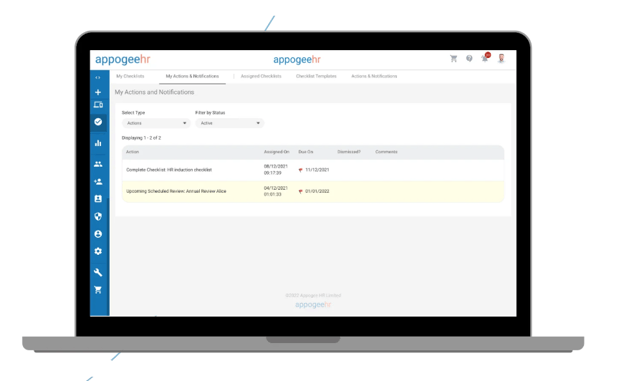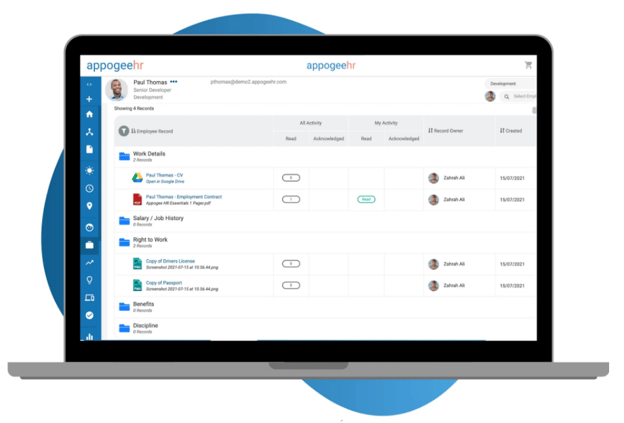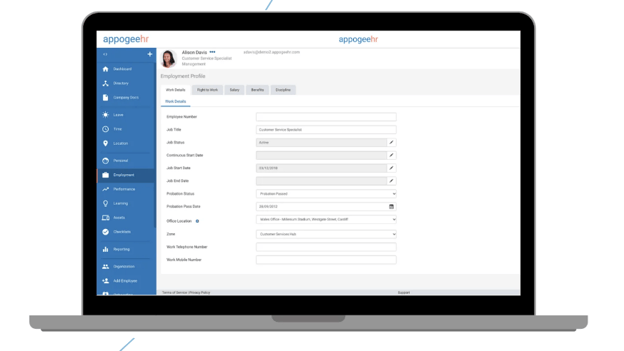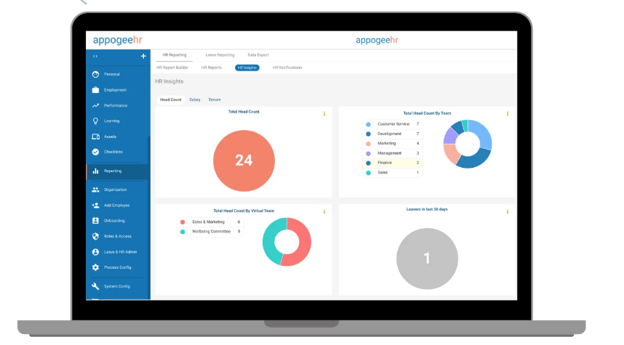Why it's time to ditch spreadsheets and streamline your HR processes
Spreadsheets containing sensitive employee records and payroll information create a range of difficulties for HR teams and business leaders. Limited accessibility, security, and organisation of critical HR-related documents and data pose real challenges.
Not only that, HR professionals are constantly doing more tasks with fewer resources. But, with the right tools and techniques, you can shift from using spreadsheets and transform your HR operations.
Considering an estimated 3.2 million small-to-medium businesses (SMBs) rely on cloud-based HR software to manage and administer HR functions, it’s time to leave complex spreadsheets behind and say goodbye to filing cabinets.
Streamline HR processes and remove unnecessary administrative tasks. This article will explain why having a centralised cloud-based employee record management system is no longer a nice-to-have; but a must-have.
Why manual spreadsheets are past their sell-by date?
The use of spreadsheets in businesses goes way back. Spreadsheets were among the first software applications developed for early computers, and they quickly served their purpose in various industries.
While spreadsheets are versatile tools, they remain limited and present multiple problems when used extensively for HR operations. For example,
- Prone to errors. Manual data entry in spreadsheets is susceptible to human errors, which can lead to significant mistakes in calculations or data.
- Increased work in silos. Sharing and collaborating on manual spreadsheets is time-consuming. Different HR colleagues and employees can't work on the same document simultaneously–increasing the time needed to perform the simplest tasks.
- Limited scalability. As your organisation grows, so does the amount of people data you will hold. Managing the increase in data and employee records using manual spreadsheets becomes more complex.
- Increased security risk. Traditional spreadsheets may not offer robust security measures–making sensitive HR data, such as payroll and medical information, vulnerable to breaches.
- Difficulty in data analysis. Extracting real-time insights from manual spreadsheets requires extensive manual effort and slows decision-making processes. For example, waiting for an HR colleague to analyse employee engagement levels can delay the start of new initiatives.
- Duplicated records. Keeping track of different spreadsheet versions can take time and effort, leading to confusion and potential mistakes.
- Repetitive data entry. Manual spreadsheets lack the automation capabilities that modern HR software provides for tasks like payroll, time tracking, and employee management.
- Compliance challenges. Meeting HR compliance regulations is more difficult when relying on manual spreadsheets. Spreadsheets lack automation capabilities for regulatory reporting or tracking employee certifications. Maintaining a comprehensive audit trail for HR activities is often impractical with manual spreadsheets.
Switch to a centralised cloud-based employee record management system
HR transformation combines a wide range of activities, from digitisation and talent management to process optimisation and cultural shifts–all designed to create a more agile, efficient, and innovative HR department.
Unsurprisingly, organisational design and change management is a top priority for 53% of HR leaders. Organisations that streamline their HR processes and ditch manual spreadsheets are more efficient.
Let’s take a deeper look at these efficiencies. Discover the real benefits of transforming your HR operations by eliminating manual spreadsheets.
1. Increase productivity
Spreadsheets are time-consuming. Plus, you need a particular skill set to understand formulas, sorting, filtering, and pivot tables.
With a cloud-based HR system, like Appogee HR Essentials, routine operations are simplified. User-friendly interfaces allow HR professionals and employees to navigate the system and perform tasks efficiently and quickly.
Since HR teams spend significant time entering, updating, and verifying data, HR management systems increase efficiency with features like powerful workflow automation tools.
Get rid of spreadsheets containing manual checklists for setting up new employees or leavers, training completion, or another process specific to your business.
HR technology can effortlessly build and manage employee workflows and checklists–helping to reduce the administrative burden and focus on more value-added activities, such as relationship building, development of new policies, and other strategic challenges.
As well as the significant benefits people management software brings to HR teams and business leaders, the advantages for employees are not to be underestimated.
According to a study by McKinsey, employees spend up to 1.8 hours per day, or 9.3 hours per week, searching and gathering information. Maximise productivity by standardising how employees find and receive information, such as training events or company policies.
Take it from Anne Mwicigi, HR Shared Services Manager at M-KOPA, who says, “Using the other platforms, we still had to manage a lot of staff data in Excel spreadsheets, which was inefficient and very manual.
“The best part of the system is the leave management software - it allows employees to simply submit their requests, while HR can oversee all the allowances. Appogee HR Essentials will calculate everything for us and has significantly reduced the HR team workload”.
Optimise your small businesses' productivity by switching between different applications. Appogee HR Essentials, for example, integrates seamlessly with Google Workspace, Office 365, and many other platforms, such as Greenhouse, Teamtailor, and LinkedIn Talent Hub. Access the information you need without disruption.
2. Improve data accuracy
Picture this.
Your people currently input their working hours and personal details on a spreadsheet. A simple error results in an incorrect salary– increasing administrative time spent correcting the mistake and liaising with your company bank to withdraw payment.
Rectifying wrong information is a costly exercise.
HR systems include features that automate data entry and updates. When employees input their information directly into the system, it reduces the risk of human error associated with manual data entry. For instance, when employees update their working hours on Appogee Time or contact information through a self-service portal, the HR system automatically updates the records. Unlike spreadsheets, this ensures that employee data is accurate and up-to-date without relying on HR staff to make changes manually.

Secondly, HR software has built-in validation rules and error checks. These checks review data for accuracy and completeness, flagging discrepancies or missing information. HR systems alert an employee if they enter an invalid date of birth or if specific fields are left blank. This real-time validation helps prevent incorrect data from being entered and ensures that only accurate information is stored in the HR database.
Human error is inevitable when working with spreadsheets. Say goodbye to traditional spreadsheets for good by centralising employee profiles and records.
Give employees the comprehensive tools to maintain their own personal details accurately. Remove the need for spreadsheets, paper-based filing systems, and lengthy HR admin procedures.
Give departmental managers one single source of truth. Free up time that could be better spent on more strategic HR tasks. Help them access everything they need about an employee, including employment history and personal details, from one central location.
3. Meet compliance requirements
HR compliance regulations, such as the General Data Protection Regulation (GDPR) and Working Time Regulations (WTR), are essential for maintaining fair and ethical workplace practices. Failing to comply with these regulations can result in legal and financial consequences.
Keeping up to date and maintaining HR compliance records is critical for building employee trust and maintaining your business reputation. Since business compliance regulations are subject to frequent updates and changes, keeping spreadsheets up-to-date with the latest requirements is labour-intensive and may lead to compliance gaps.
Plus, as spreadsheets are not well-suited for long-term historical data retention, storing important information for compliance reporting and audits poses real risks. Spreadsheets can be vulnerable to data loss due to file corruption or accidental deletion, potentially resulting in the loss of critical business compliance information.
Given these risks and limitations, opting for specialised HR software to maintain accurate records is essential. Versioning features allow you to keep track of your company documents and policies–reducing the risk of having outdated information.
Keep track of company documents and procedures. Digital HR document management software, like Appogee HR, lets you store and share all company documents and policies from one centralised platform.
Improve accountability and easily manage read requests with acknowledgments in the system. With centralised document management, you and your employees will save valuable time looking for the most up-to-date policies, ensuring your company complies with regulations.
Have better data validation, security, automation, reporting, and audit trail features–designed to mitigate compliance risks and ensure all your business compliance data's accuracy, security, and integrity.
4. Offer a better user experience
Spreadsheets often have a steep learning curve, especially for employees and HR colleagues unfamiliar with the software. Users may find it challenging to understand complex functions, formulas, and features–hindering productivity.
Streamlined HR processes enhance the employee experience. Unlike manual spreadsheets, HR software has easy-to-use employee profiles and records. This gives everyone access to simple self-service tools like requesting time off, updating personal information, and accessing payslips. This can boost employee satisfaction and engagement. In fact, 47% of HR leaders say employee experience is a priority for 2023.
Well-organised dashboards, clear navigation menus, and user-centric design elements make it easy for HR professionals and employees to quickly access the necessary information and perform tasks without extensive training or assistance.

5. Make better decisions
Let’s face it: spreadsheets are limiting. Considering HR is viewed as a strategic partner, having data in silos that is restrictive can make it challenging to access real-time information for decision-making.
Let’s say you currently rely on spreadsheet data to record employee performance data. Errors, such as incorrect ratings or missing feedback, can result in making the wrong decision. Your underperforming employee is promoted, while a high-performing employee is overlooked for advancement. This can lead to reduced morale, decreased employee engagement, and increased turnover among the best employees within your company.
Get a holistic view of the information needed to make informed decisions. All-in-one HR systems usually have robust reporting and analytics features, allowing you to gain valuable insights from HR data. This can help with workforce planning, talent acquisition, and other strategic HR decisions.
- “[Appogee Time Tracker] really highlighted different working practices across departments and gave us the ability to define how to input data properly, and this has elevated utilisation up to board level to review activity every month from the company.” –Dave Fenton, Vice President of Services at Ancoris
Secondly, reduce the need to analyse lengthy columns of data on spreadsheets. Save time with HR reporting–schedule and automate various HR reports.

Besides standard HR reports, technology allows you to customise employee reports based on your business needs. Whether you’re a small business or a mid-sized organisation, filter data to view precisely what you want to see and sort reports according to what information is essential to you.
6. Collaborate with remote and hybrid employees
Many businesses now have a remote or hybrid workforce. Ensuring the security and privacy of employee data in spreadsheets can be challenging, especially when multiple individuals have access to these files remotely.
HR technologies can help you successfully manage hybrid working models. For example, time and location tracking tools allow staff to record when working from home and in the office, giving you real-time information on who's available for face-to-face meetings or video chats.
But don’t take our word for it.
Yappy is an e-commerce company specialising in personalised dog and cat products in the UK and the US. The brand relied on Excel spreadsheets to manage staff leave for their 36 employees. Tracking leave and sickness with ever-changing team structures was challenging.
Since implementing Appogee HR, Yappy streamlined how employees record their working hours, reduced HR admin, and improved data security.
- “It’s an absolute no-brainer: the money we have saved in employee time since implementing Appogee HR far outweighs the cost!” –Matt Roche, Management Accountant at Yappy
Centralise your employee records and eliminate the need for spreadsheets. A cloud-based employee management system is accessible anywhere on any device, helping you maintain security and accessibility regardless of work location.
Transition from traditional spreadsheets to efficient HR practices
While there is an initial investment for HR software to streamline HR processes, the early outlay far outweighs the cost. Make substantial cost savings in the long run by replacing spreadsheets–reducing manual labour, minimising errors, and optimising HR operations.
The bottom line? HR technology is far more cost-effective than maintaining and upgrading complex spreadsheet systems. Scrap complex spreadsheets for good in favour of a centralised cloud-based employee record management system and reap the rewards.
Ready to ditch the spreadsheets? We have a range of package options to suit your business needs. Learn how Appogee HR can transform your people operations and book a demo with our team HR Transformation Team. Alternatively, you can start your free 14-day trial with us today.
Citing various sources listed below:
Business.com
Gartner
HR Vision
McKinsey
The Working Time Regulations 1998
.webp?height=168&name=appogeehr%20(1).webp)




